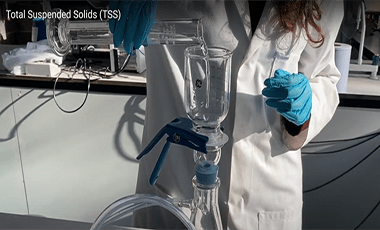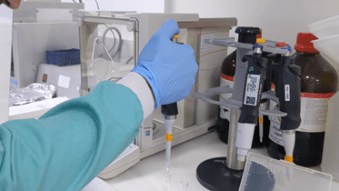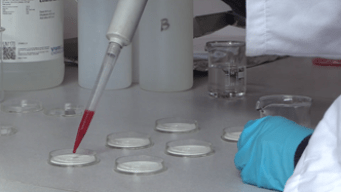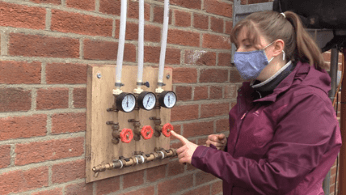Improving Access to Practical Elements of Environmental Engineering
Overview

This Learning Enhancement project has been funded through the HEA and the National Forum for the Enhancement of Teaching and Learning.
| PROJECT TITLE: | Improving Access to Practical Elements of Environmental Engineering |
|---|---|
| PROJECT COORDINATORS: | Dr Sarah Cotterill |
| COLLABORATORS: | Ms Puneeta Sreevinas, Ms Linda Heerey, Dr Sam Bhatt |
| MODULE: | Introduction to Water Resources Engineering 2 |
| MODULE CODE: | CVEN40230/ CVEN40630 |
| STUDENT COHORT: | Two cohorts of Postgraduate students, full-time & Part-time. Approximately 30 students attending in person and 10-15 students online. |
Background
In an applied subject – such as engineering – practical, hands-on learning opportunities are invaluable. Student and external examiner feedback has emphasised the value that students place on laboratory and practical classes, and the desire to incorporate more of these activities into the modules offered. This project focuses on two modules which are delivered simultaneously to two cohorts of students; in-person and online.
In a mid-module survey in 2019/20, the majority of students taking ‘Introduction to Water Resources Engineering 2’ stated that they would like more practical experiences in the module. Unfortunately, integrating practical applications of environmental engineering is not always possible because of resource and timetabling constraints, mode of module delivery (particularly for the online-only students), or, as we saw in 2020, restrictions limiting face-to-face teaching. Aside from this, some students, particularly those doing science-related subjects for the first time, can find laboratory classes stressful and don't always feel prepared for in-person activities.
This project sought to deliver practical relevance for taught content, in a time-efficient manner, whilst removing some of the anxiety some students feel.
Goals
The aim was to develop a suite of digital materials which could support practical sessions by:
- cutting down the length of time the students need to be in the lab or on site;
- increasing the number of practical sessions they could engage with;
- providing resources to revisit and reinforce learning;
- enable delivery of practical sessions for distance learners.
These goals became increasingly important with the restrictions on face-to-face delivery arising as a consequence of the COVID-19 pandemic. The original hope was to develop digital resources alongside physical laboratory time to provide flexibility in learning style. Previous studies have shown that students are generally positive about the use of virtual technologies, so long as they are not used to replace in-person learning entirely, and instead, are used as an additional tool (Spicer & Stratford, 2001). The integration of virtual and physical laboratories alongside one another “offer advantages that neither can fully achieve by itself” (de Jong & Zacharia, 2013). The aim was to develop a collection of digital resources including step-by-step demonstrations of analytical techniques; interactive elements that enable data to be collected from video-recorded experiments; animations of (time-consuming) laboratory protocols; and a virtual tour of a water or wastewater treatment plant.
The Innovative Approach
Ten videos and animations were created, including:
1. Demonstration of analytical techniques, such as how to use a pipette or a pH probe.

2. Interactive digital labs, such as enumerating bacteria through membrane filtration, determining water hardness through titration, and calculating biochemical oxygen demand.

3. Physical demonstration of lab facilities to support taught theory (e.g. rainfall simulator); and

4. A virtual site tour of wasterwater treatment works.
Videos of laboratory procedures were recorded using readily available audio-visual equipment (i.e. GoPro, mobile phone, tripod, and clip-on microphone) and edited in iMovie. Animations were created in OpenToonz and Blender, following participation in the “Digital Animation for Educators” course.
Videos were uploaded as ‘unlisted’ links to YouTube, and included as hyperlinks in a student workbook which also contains photos, data, calculations and context. Datasets are paired with videos of protocol and questions exploring their understanding of aspects of the method and data collection (e.g. equipment uncertainties) and the implications of the results.
Results
Results
- Students were surveyed before and after the use of virtual video labs.
- Survey completion rate was good (~40% of cohort).
- Previously, 50% wanted more practical activities, with 38% stating they were happy with the current amount, and 12% stating they did not want more practical work.
- After implementing virtual labs, only 20% requested more practical opportunities, with 60% stating they were happy with the amount provided.
- All respondents thought virtual labs were relevant to the module.
- 80% thought virtual labs were “a good alternative to physical labs, given the current covid restrictions”.
- 30% also added (students were able to tick more than one option) they thought they were a “useful tool to support learning”.
- Virtual labs can provide a solution to space, equipment.
These interactive teaching materials, including practical laboratory procedures, will be used and improved over the coming year(s). Further work will be done to evaluate how a hands-on laboratory session can be included in the module, blending physical activities with some virtual components. Two lab books were created: Water Quality and Wastewater Treatment. If you would like to access a copy, please contact sarah.cotterill@ucd.ie.
Resources
Due to the suspension of face-to-face teaching during COVID-19 there is, now, quite a variety of guidance and resources available on virtual or simulated labs. This includes:
- Information on how to create your own (i) video footage and/or (ii) digital animations.
- Guidance on how to achieve learning outcomes in remote labs – e.g. The Remote Practicals Playbook from University of Sheffield.
- Free to use, ready-made, online labs e.g. Learning Games Lab at New Mexico State University incl. labs on water quality sampling and testing (CONSERVE) and infiltration and runoff (Western Soils).
References
- Spicer, J.I., and Stratford, J. (2001) ‘Student perceptions of a virtual field trip to replace a real field trip’. Journal of Computer Assisted Learning. 17(4), 345-354
- de Jong, T., Linn, M.C., and Zacharia, Z.C. (2013) ‘Physical and Virtual Laboratories in Science and Engineering Education’. Science. 340 (6130), 305-308